Conceptual wonderlands and the digitalised-self.
It’s definitely time for a KABK graduation again… For the day, we also were graced by meeting the faces of the school’s several Art degrees. This crafty bunch had come armed with film, photography and installation delights. Each chat brought us into conceptual wonderlands as it became clear that a critical eye and a delicate hand produces greatness. We saw performances, portraits, and a definite theme of the digitalised-self. It was a pleasure to experience self-expression and contemporary reflection, so we couldn’t resist sharing with y’all too. Enjoy!
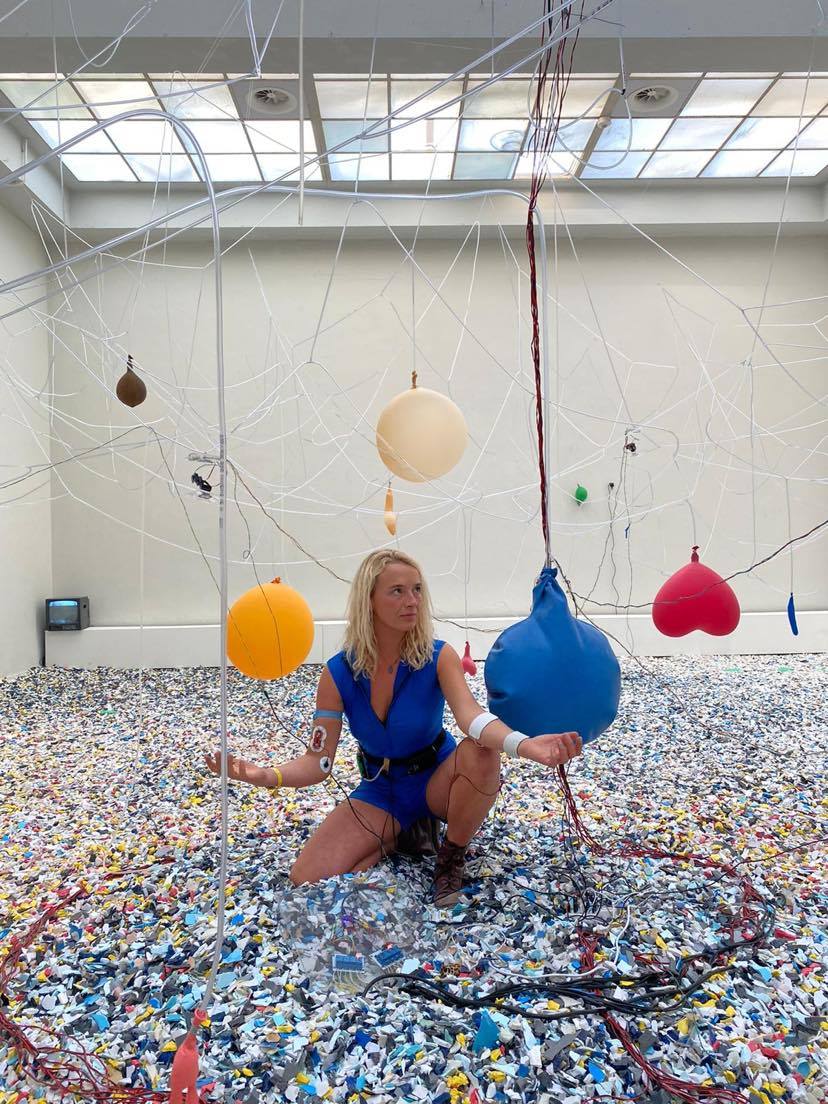
Hi! Can you tell us a bit about yourself?
I was born and raised in Cape Town, South Africa. I lived there my whole life and enjoyed nature and living through my body. This means I have always been interested in making experiences and creating worlds.
What is the inspiration for your graduate installation piece?
[Last year] I was doing a performance on a live stream website and all my classmates were watching. Because of the delay, they were only reacting a few seconds after I did anything. It was really weird because they were in the same space as me, but they were not really with me, they were in another world. This got me thinking – where does your body go when you are online? So the project started as a way of showing people that there is this interconnection [between physical and the digital worlds] that we don’t really see.
Has it been challenging making work in the lockdown period? It’s a massive installation piece! I’m guessing you won’t have seen it up and finished until now?
Exactly! During lockdown I travelled a lot with the installation. I would put it in my shopping cart and go to a warehouse with my friends so that I could build the project up. This final version is the biggest, most balanced and best thought out. However, during lockdown it was interesting to play around with how adaptable the installation would be.
What do you want to do next now you have graduated?
[With the graduate work] I actually just finished a residency at V2 in Rotterdam. After this, it’s going to another exhibition in Eindhoven.
Wow! So you’re experiencing a taste of success already.
Yeah! I’m so happy about it because really this piece is really just me. It was something in my brain until not long ago, but now it’s out in the world. 🙂
I bet that feels amazing to have your ideas out there and expressed. We’re happy for you Marlot, thanks for talking!
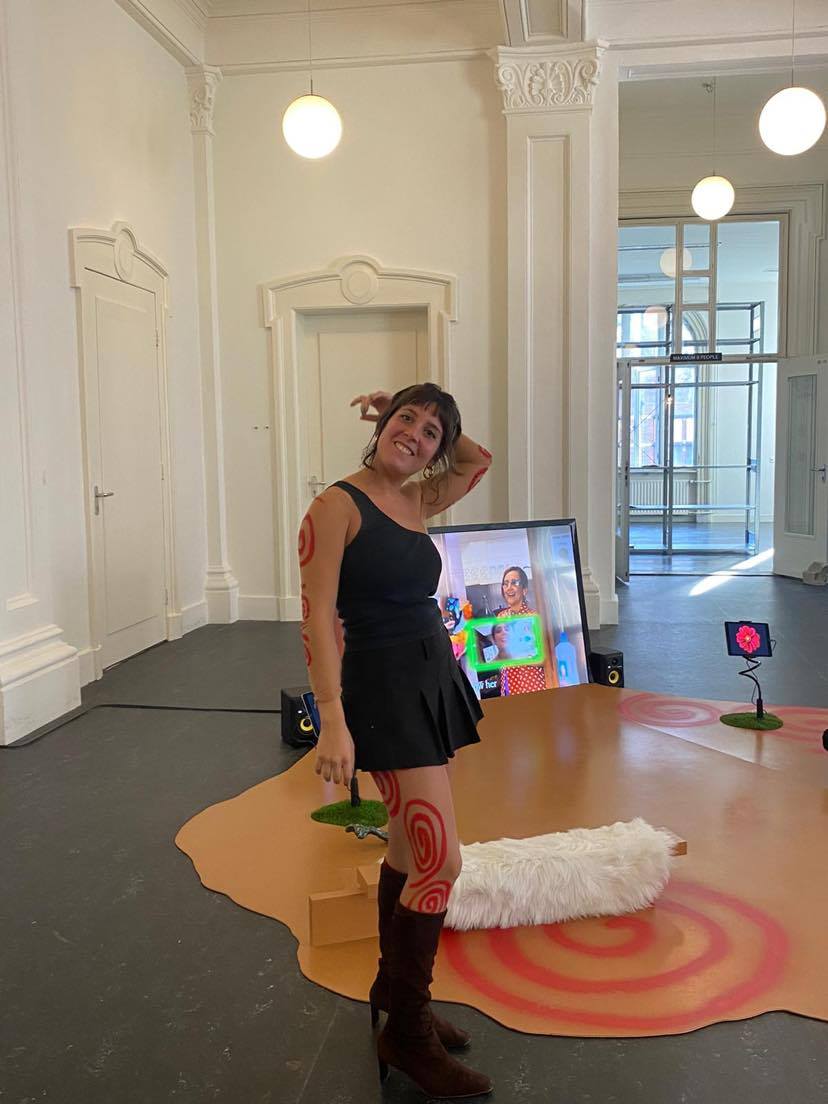
Hey Carmen, we love that you used your family as actors in your video work!
Well, my mum used to be an actress! That’s also where I get the impersonations theme in my work.
Yes, we noticed how there were many characters in your graduate piece. Can you tell me a bit about how this comes together under your concept?
It’s essentially all about masks and getting to know yourself through the different personas which you can interpret. [I figured] because we’re always different with the different people we’re with, we should embrace it.
Performance and role-playing is key to your work. Why do you think this medium best suits the concept of masks?
At first, I was writing about the masks that we wear in front of other people versus the ones we wear when we are by ourselves. This was done in Ancient Greek rituals, where they would put on masks so that they could be more authentic and forget things for a sec. Then, this translated so perfectly with the idea of Instagram face filters and the type of masks which break the fourth wall. Suddenly faces and their personas became important again.
Was it challenging for you to do your graduate project during the lockdown period?
I went back to Spain and it was all planned to be done in a week and a half. The first day of filming, suddenly we couldn’t leave the house. Whenever I needed to go anywhere, I had my granny-shopping gear with tomato cans stacked on the top to avoid the police giving me a fine.
It’s kind of a clandestine project then!
Yeah!
How much did your project change owing to the regulations?
The original scripting had to change completely because I couldn’t go to the woods to film anymore. However, the initial idea was still along the lines as what you see in the final project. It became more concrete with quarantine because I was in my thoughts a lot.
It [also] became a lot more parodic, particularly my accent (that’s not actually my accent in Spanish) because the audience has also become more serious over the past few months. Some of the characters are more clichéd, more Southern [Spanish] or flamboyant.
So it’s kind of an anti-lockdown antidote then?
Yeah, it’s funny, but it is also real, and that’s how it became a bit existential – through the character’s deepest thoughts. [The narrative] is about gossip and how it is always seen as bad, but I have grown up watching all my family gossip and then they end up saying things that they can’t even tell their partners.
That sounds both amusing and cathartic actually. What was the biggest challenge and the reward through your degree? What would you say looking back at it?
When you’re in the art school environment, you’re supposed to sound smart, look smart and everything you create is supposed to be an intelligent, new way of doing things. When you get stuck you also have to pretend a bit to be smarter. But I think when I let that pretending to go it was so much easier to just start creating.
Wow, that’s such a wise statement. But there’s still such an aspect of performance in your work. Do you find that performing identities through the characters, instead of yourself, helps you to let go?
Absolutely, 100%.
Thanks for your time. Enjoy the rest of your show.
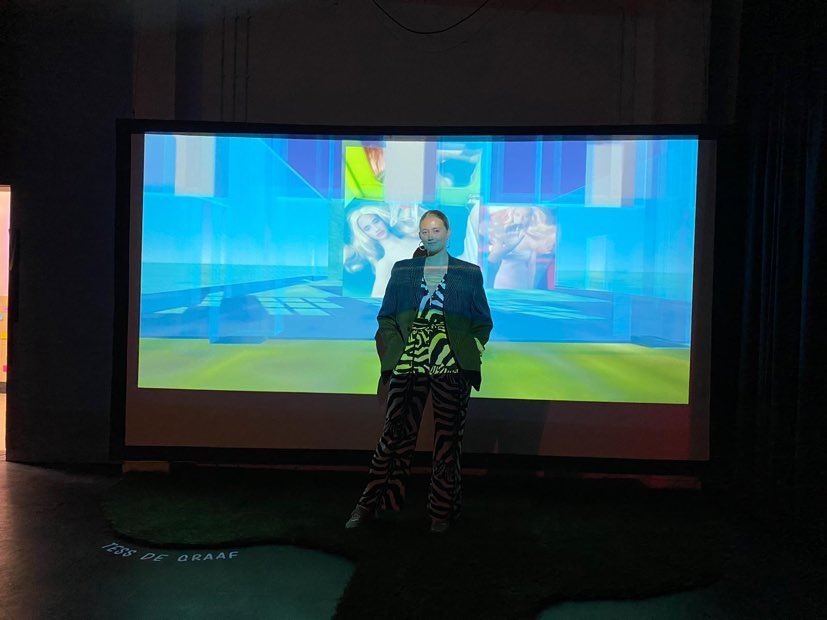
Tell us a bit about yourself
My name is Tess, I was born and raised in the countryside in Bergambacht, but now I live in Amsterdam.
What is the inspiration for your graduate project?
We’re so dependent on our phone and our digital identity, but it’s something that you cannot grab, it’s so elusive. I wanted to create a character which existed only online in this video piece.
So what form does this character take?
Well, she’s half-me and half a doll, which also means she’s half-doll, half-human. Her name is “1,6” because she’s a 1,6 scale, just like a barbie doll. And she’s stuck in pixels forever!
You directly placed yourself in your work, then? How easy is it to do that?
I think we all do it anyway. When you start as an artist you find something that intrigues or is a challenge to you and then make something with that. It’s also therapeutic to go through that process. The digital doll came from a physical maquette, so it’s not really, really me. Originally it’s from China and it’s actually a sex doll! I wanted to use her because I thought she was so beautiful with her silicone skin and her skeleton made of wire… she’s very bendable.
What inspired you to use aspects of the digital in your project?
I’m so addicted to my phone it’s unreal. And I always wonder whether I still have choices in my digital world. Everything I look up, I get commercials for, and all the data I create when searching all gets collected somewhere. It’s scary to think about.
But your work is more reflective, as opposed to reactionary, about the state of things. It’s almost like saying “hey, this is the state of the world right now, let’s make some art out of it.”
Yeah, exactly. Honestly, we’re all stuck to the internet, and we both hate it and love it.
What do you want to do now you have graduated?
Keep making, keep creating. Especially now we’re not the slaves of the school anymore! I have a vintage store I run, but I’m also open to working in a magazine or in the commercial world. As artists, you can put us anywhere, I believe.
Yeah – whoever said artists aren’t employable? Totally employable! Thanks for speaking to us.
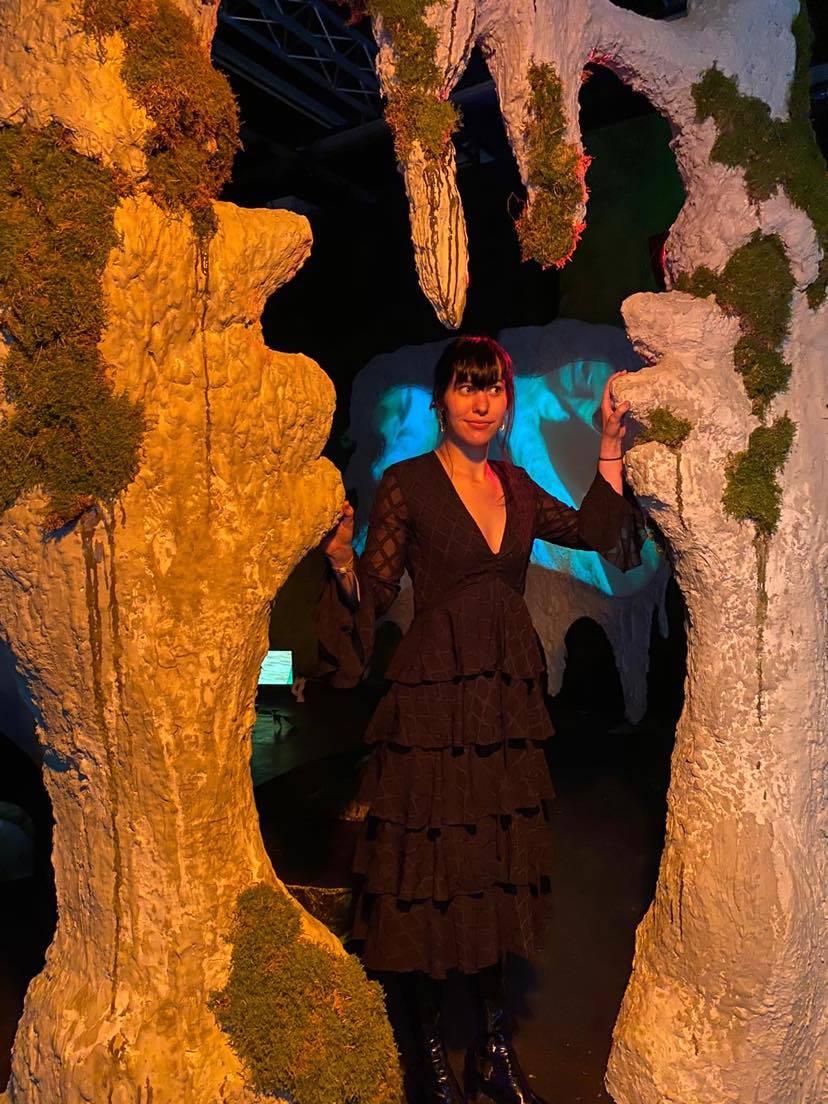
Could you tell us about yourself? I studied photography, but my work is more digital: video games etc. It’s more about the environmental space in the digital world. My photography, Although I am perspective, I am still exploring this fantasy world.
What has been your inspiration for this piece?
I started with the post-apocalyptic idea of the world. I used to play a lot of video games, so it really touched me how I can easily live in an environment and I got completely carried away with it. When the dark crystal came out- I was like “this is so amazing!” I had to cry. I think, why can’t we make a world like this fantasy, where things are more organic? For me, it was a challenge to make a video game that is accessible for everyone, so that they can experience what I feel. It’s about creating a new-shaped life, coming back to the core of mother nature. Everything in this game is looking for the gate and reaching a new dimension. This symbolises how we perceive dimensions here on earth. We also see gates as a symbol of another realm.
Gates are very much a symbol of a new beginning, or rather, an end… we use them all the time!
It is a boundary between a couple of words, it resembles a coming together. We don’t have to be scared. Life is all cycles. That’s why I wanted to create the unknown. Sometimes it’s difficult to understand…
You are graduating at a crazy time! What’s next for you?
I do a lot of collaborations. I also create 3D sets for photographs for example… In the future, I would like to move to this type of world where different strengths and skills come together as a team. Working more on this game is also very exciting, getting exposure and getting me closer to having a team so that I could have a small game company. It’s such a male-orientated industry, but there are so many female gamers coming! We need more involvement!
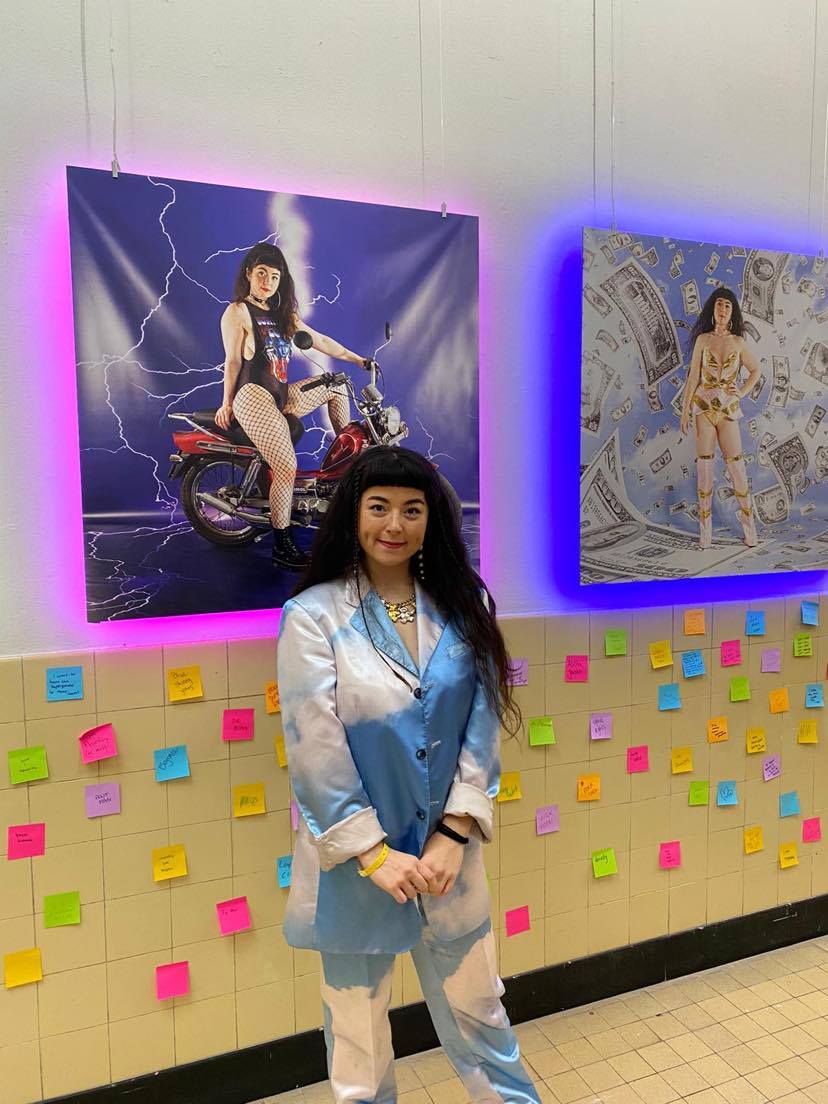
Hey Naomi, such a great self-portrait series. Can you tell us about yourself?
Of course! So my name is Naomi, I’m 25 and I’m half-Dutch, half-Korean.
What is the inspiration for your graduate project?
I love the idea of bringing things together from different worlds. I am inspired by performance-art, acting, dance and colourful pieces. I love creating sets with costumes and a mood/vibe to them. One of my favourite artists is Yayoi Kusama, so you can definitely see her influence here too! I’m also influenced by anime such as Studio Ghibli or Sailor Moon.
Did you find it challenging creating this during the lockdown period? How did your creative process change?
It was tricky at first because I couldn’t meet up with anyone who could help me with the project with styling or photography. In the end, I had to do this all by myself, including learning how to take self-portraits with the shutter timer on my camera and have them still look good! In the end, I turned out to be really glad to have something creative to do, and have these alternative worlds to dive into which were outside of the real-world chaos.
What kind of community do you think your work speaks to?
In general, I would say a Queer audience, as there is a strong focus on “being who you want to be”. However, I think my work can also be related to by anyone who is going through a bit of an identity crisis. This idea that you can be anything is really empowering when you learn to play it up – one minute you can be a shy girl and the next a hero.
What has been the biggest milestone over the past few years?
One of the biggest challenges for me was learning to focus on myself in my work. I wanted to do something about self-expression, but when I first started I never used to take selfies or put myself in front of the camera. After a while, I gained confidence by taking photographing myself and trying out different personas.
What do you want to do next now you have graduated?
Well, I would like to keep creating and doing more projects about identity, femininity and sexuality. In addition, I’ve already begun by restarting a “Humans of Rotterdam” project (based on the “Humans of New York” Instagram) which I originally created a couple of years ago. It will be up and running as an Instagram in a few weeks!
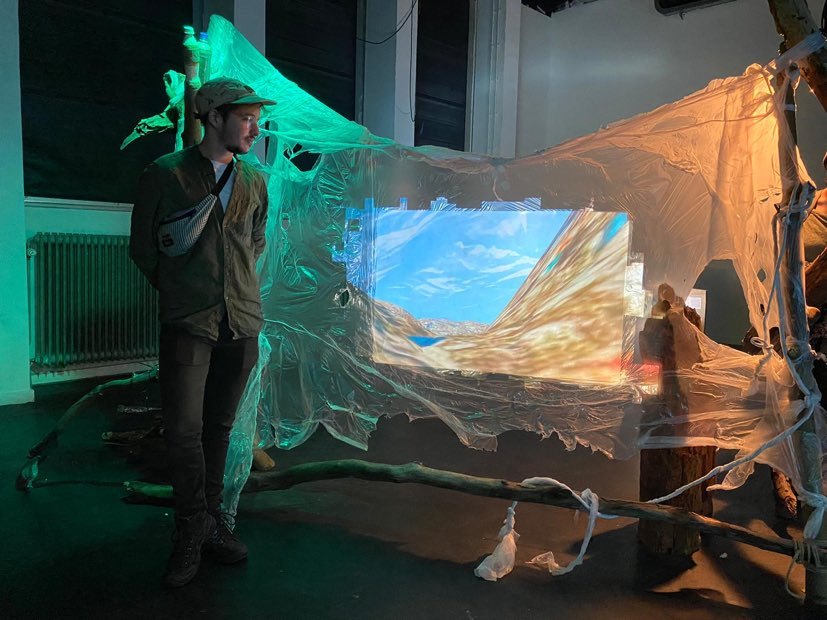
Hey! Could you tell me about yourself?
I like to describe myself as a left-handed, transgender person, half Lebanese, half Dutch, with ADHD and autism. All of this has made me look differently at the world. I have always felt like an outsider, but that has made it pressing for me to share my view of the world- because it was the only way I could feel connected. I also feel weird about selling art! Even though I need to to survive!
Why so?
I like to give art as a gift. I like to show people affection through creation.
There’s something so human behind your art, what community do you think your work speaks to mostly?
As I have seen people walkthrough, I notice it is a younger audience. I think this is for two reasons: one being aesthetic, the other being the fact we are very confused about our future right now! My work is a physiological tool to help cope with something that is very difficult to deal with. Sometimes you meditate to feel the discomfort so that you can feel it, and let it seep through your body so that you have a clear mind.
Like a process of purging.
Yes, the stress reaction and the cognitive dissonance that comes is a huge issue. As an individual I cannot do very much about it, expect to sit with it and afterwards think about it in a much more creative way. Stress blocks creativity.
It must have been a challenge graduating as the COVID class- what have the past couple of months looked like?
I am a very wavy person. I’m quite sensitive so the beginning of the lockdown was very good for me. For me, it’s very difficult to go to places, because I become tired and can’t produce anymore. It was good to be online, and continue to work. I had more time and space to create. Of course, after a while, you become a bit secluded from the world which was difficult. My work, however, does not depend on people standing 1.5 m apart…
What do you want to do now that you’ve graduated?
I have applied for 1 grant, and I want to apply for more. I want to continue on this project and I hope to start developing adventure games for this. I hope to get a team!
Words by Rose Holmshaw